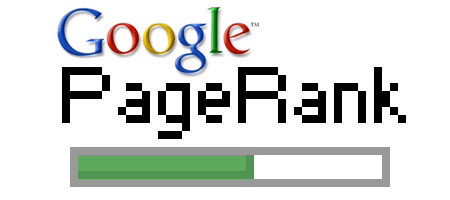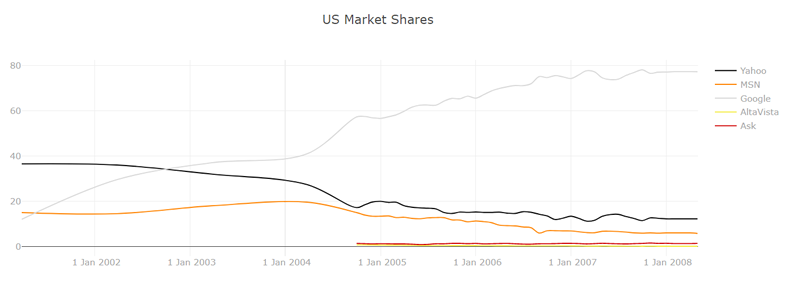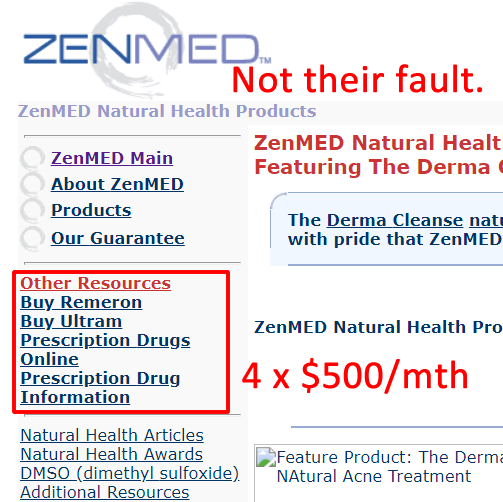There was once a time when there was no SEO metric more important than PageRank.
You could buy it.
You could sell it.
And that was the problem Google created for themselves when they gave us pesky marketers the green bar.

It was called toolbar PageRank.
And it broke Google.
We’ll get into that a bit further below.
But first, let’s go back even further.
The Origins of a Search Engine
In 1996, Sergey Brin and Larry Page, together with some other academics at Stanford who likely regret not getting more heavily involved with what it became, developed and patented the system that would be trademarked as PageRank.
The patent for the system was granted to Stanford, and Brin and Page gave up shares in Google for exclusive rights to it.
Shares that sold just 9 years later for over $300 million.
But what made this patent so valuable?
What was PageRank?
PageRank Revolutionized Search
In simplest terms, PageRank brought links into the ranking equation.
It’s easy to see where the idea came from.
You have a group of academics sitting around doing research.
They’re following citations in papers and noticing that the more times a paper is referenced by other papers, the more relevant and important it seems to be.
Bingo!
You have the foundation for link-based search algorithms.
I can also fully understand the frustration they were solving.
I first attempted to work on the internet in 1994 (about the time the idea would have been occurring to the paper’s authors).
I was doing some research for a poli sci paper I was writing at the university computer lab.
The search engine was Yahoo.
And I was miserable.
I remember having seen a show on chat rooms and attempted to find one where I could get some direction on where to find what I was looking for figuring if they were really popular they should be easy to find.
I couldn’t even manage to find that, and about 30 minutes I was in the university library.

Using search engines at the time, I spent probably about an hour not finding what I wanted.
It was faster to walk to the library and copy out what I wanted by hand.
It was a good few years before I tried going online again.
I continued to use computers, just not the internet. Stuff was just too hard to find there.
So, Brin and Page added links to the formula.
This is not to say that the entire Google algorithm was based on links, but this was the first time links were used by a search engine in a meaningful way.
Google rolled out in 1998 and this revolution produced the following in market share numbers:

If you’re new to search, there are probably a few names in that image that you don’t recognize. You can thank Google for that.
PageRank had such a massive impact on the quality of search results that, within the span of a decade, it took Google from a startup to power 4 out of every 5 queries.
Basically, it took the internet from a zone that this author left in frustration – to one that even the least technically proficient people could easily find mainly relevant information.
And Then Along Came the SEO Folks

We’ll get into how PageRank functions shortly, but first let’s dive into the folks who broke and continue to break it.
Us.
Well, some of us.
Starting in 2000, Google added a visual green bar to their toolbar.
This green bar reported a PageRank score from 0 to 10 for any webpage.
What did this mean at the time?
- Links became hugely important.
- Because very few people were doing SEO, competition was very low for most terms.
- Google just gave us all a metric for measuring the value and potential impact of a page.
- Most penalties were manual, so there was a huge lag time between spamming and penalties. But even then, getting a penalty would have required someone manually reporting your site – or an act of flagrant stupidity by the site owner (confession coming below).
It was a perfect storm for spam.
We knew the value of our pages and the value of pages linking to us (and our competitors).
And a whole marketplace opened up buying and selling links based on PageRank.
The Aforementioned Confession
Back in this early era of SEO, I was an affiliate marketer.
I was willing to burn sites to the ground knowing I had a dozen more coming up behind it, and probably a couple of others occupying additional positions for the queries I really wanted.
I had a nice little site promoting natural health products. It was earning a tidy $3,000/month in affiliate revenue, which added nicely to the other sites I was managing and had a PageRank of 6.
A link on a PageRank 6 page was worth hundreds and a ROS (Run-Of-Site) link was worth (as it turns out) about $500/month.
Which led to:

Woohoo!
An extra $2,000/month!
Except that I got stupid and greedy.
I posted the “opportunity” on a link auction site (yup, that’s how monetized they got).
The next update my site dropped to a PageRank 2.
The rankings plummeted.
My general site revenue fell to about $200 and the advertisers left because the links were only worth about $30/month now.
I post this confession of an internet spammer, to highlight the problem with showing everyone what their PageRank was.
It was intended to let searchers know the quality of the site they were on – and let SEO pros know the value of what they were doing from a link perspective.
This is why we can’t have nice things in SEO.
Toolbar PageRank vs. PageRank
We mentioned above that PageRank was scored on a 0 to 10 scale.
This was toolbar PageRank and was an estimate of the real PageRank.
Internally, I’m sure the numbers were far more complex than what we were seeing.
But in April 2016, like the last message sent from the Mars Opportunity rover, their patience ran low, and the toolbars went dark.
This was not the end of PageRank, just its use as a commodity.
As Matt Southern wrote at the time:
“Google has officially shut down toolbar PageRank to the general public. Meaning, internally Google will still be using the data, but it will no longer be visible to the public.”
We don’t talk about it much anymore because we can’t see it.
But it’s still there – and it still holds a powerful grip on rankings.
It is what makes a link powerful and some links more powerful than others.
PageRank – What It Is
The initial patents were pretty basic.
They focused mainly on volumes of links with little emphasis on position or other factors (probably because we hadn’t started manipulating things yet).
Later patents and updates added in aspects (e.g., position and trust factors) based on seed sets (essentially the manual selection of trusted sites which would pass trust downward to sites they linked to).
We could call it TrustRank, but I generally consider it part of PageRank.
For more on that, I’d recommend a great piece by Bill Slawski which you’ll find here.
I personally don’t believe the trust process is fully based on seed sets and likely has none at this stage if it ever did, I do suspect there are processes like it though they would likely be automated.
How PageRank Moves
PageRank moves from one page to another through internal and external links.
Because the scale of 10 is irrelevant now that toolbar PageRank is gone, let’s use a page with a PageRank of 100 as our example.
If that page links to 50 other pages, each page would get 2% of the PageRank.
EXCEPT – On every page, a small percentage of the PageRank simply evaporates. We will ignore this to keep the example simple for now, but it’s an extremely important part of the mathematics.
If you imagine PageRank continuously passing around without this built-in evaporation, every site on the web would approach infinite PageRank.
That poses some obvious problems.
Again though, for our example, we’ll simply assume each page gets 2% of the PageRank.
It then would pass on its own PageRank received from that first link as well as any other PageRank is received from other pages linking to it, whether internal or external.
So … the more links you put on your page, the less PageRank that passes through each. So that top nav with 300 links may be diluting weight from the pages you want it to the most.
This is the simplest piece of the equation as it’s fairly easily defined by division.
Where it gets foggier is in understanding how internal vs. external links are treated.
I tend to view them as separate things with different PageRank moving through each.
It doesn’t make sense to “punish” a site for linking out to a relevant resource and it doesn’t make sense to punish content sites with active comments sections, by drawing links there from the internal flow.
I’ve read a number of breakdowns and most SEOs fall more-or-less into this camp as well. External links do not impact your internal PageRank passing.
Nofollows do, however.
With few exceptions, nofollowed internal links should be avoided. If we look back to those 50 links in the example above and think of 3 of them as nofollowed internal links.
The remaining 47 pages will still only get 2% each, the remaining 6% simply evaporates. This means it doesn’t get to the target page which means it then can’t pass it along.
So while it’s true you may not want your privacy policy to rank and it probably won’t… it will pass PageRank through its own links and is better followed to do that task, than have all the links to it simply voided with nofollow.
Also, the position on the page impacts the PageRank flow.
Like content, the more visible a link is, the more weight it has.
It’s important then to ensure that your key pages have visible links.
Quick Summary of Impact
I thought it might be helpful to have a quick five-point impact checklist for each of the internal and external links. So here we go.
PageRank Impact on Internal Links
- The more links on a page, the more diluted the PageRank passed to each.
- The more links to a page, the more PageRank flow to it.
- The more easily clicked (i.e., visible) a link is the more PageRank it passes.
- Nofollow links cause PageRank evaporation, not sculpting.
- Links to other sites do not impact your internal PageRank,
PageRank Impact On External Links
- Linking to other sites does not positively or negatively impact your PageRank.
- External links do not impact your PageRank but may impact other algorithmic factors.
- Links from higher PageRank sites will send more PageRank to the target page than links from lower PageRank pages.
- The PageRank to one page on a website will pass to others through internal links.
- Like internal links, external PageRank divides by the number of links so a link from a page with fewer outbound links is worth more than one with many.
PageRank: It’s Complicated
I hope that this outline of PageRank answers a few questions.
It’s a highly complicated and complex area and I suspect there isn’t even a single person at Google who could fully outline how it works at this stage.
Hopefully, the core rules outlined above (and a bit of the history) clears up some misconceptions and has given you an understanding of PageRank that you can carry with you as you consider your internal link structure, how and where you get links, etc.
If you’re in a slightly technical mood and would like to see how your pages pass PageRank internally (based on the initial patents at least), I highly recommend trying out the process outlined by Patrick Stox here.
You’ll need Screaming Frog and Gephi, but it’s quite interesting. Once you’re familiar with the tool, you’ll undoubtedly start importing other analytics and link/page metrics into it as well.
Additional Reading
- Patent Method for node ranking in a linked database.
- Paper: The PageRank Citation Ranking: Bringing Order to the Web
- Paper: The Anatomy of a Large-Scale Hypertextual Web Search Engine
More Resources:
- PageRank Patent Update – How it Impacts SEO
- Can Harmonic Centrality Be the New PageRank?
- Harmonic Centrality vs. PageRank: Taking a Deeper Dive
Image Credits
Featured Image: Adobe Stock / Edited by author, February 2020
PageRank Image: Search Engine Journal
Broken computer: Adobe Stock
US Search Marketshare: Datahub
Matt Cutts and Broken Watch: Adobe Stock / Edited by author, February 2020
Screenshot of links sold for PageRank: Embarrassed author





